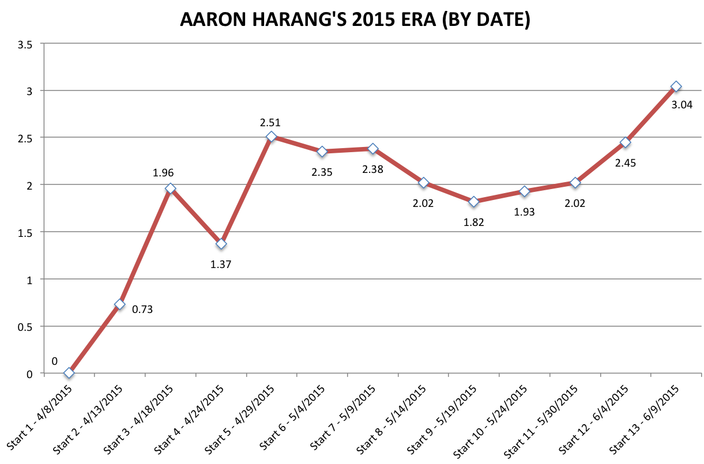
June 10, 2015
Buy low, sell high. That's how the saying goes, at least.
But when it comes to the Phillies and their most-valuable trade assets -- in this case pitchers Aaron Harang and Cole Hamels -- they seem content to allow that value to drop before selling.
Look no further than the last two performances from their top two starters.
On Monday night, Hamels had his worst outing in over a month, allowing five earned runs on eight hits and two walks in six innings. With the loss, his second in his last three starts, Hamels' record dropped to 5-5 on the season and his ERA climbed back above three (3.19) for the first time since May 18.
One night later, Harang was shelled by Reds, allowing seven runs on seven hits, including four home runs, in six innings. For the 37-year-old righty, it was his second straight poor start -- both against Cincinnati, where he spent eight seasons -- and now his ERA is above three (3.04) for the first time all season.
That's not likely to help general manager Ruben Amaro, Jr. when he gets a call from a rival GM asking about Harang.
Some will tell you this slide was inevitable. Regression to the mean. Coming back down to earth. Those people will also tell you that with each start he makes, there's a risk of injury, something that would thwart even the best laid plans. To some extent, they'll say the same about Hamels.
I'll readily admit I was one of those people. It just seemed counter-intuitive not to leverage the best version of a player -- both in statistics and health -- when sitting down at the bargaining table.
But what if, by being patient, the Phillies are doing the right thing -- or at least not the wrong thing?
Recently, a stock market whiz by the name of Billy Ray Valentine opened my eyes.
See, this whole time I was looking internally, at the factors the Phillies could, to some extent, control. Instead, I should have been paying attention to the big picture. In a month and a half there's going to be a whole bunch of pork belly contractors freaking out because they can't get the G.I. Joe with the kung-fu grip.
I was so shortsighted that I hadn't even considered allowing the market to set the price on Harang* by waiting for other pitchers to get injured, thus lowering the supply and increasing the demand. I think I learned that in a movie too. "Wall Street" maybe? Definitely not the freshman economics class I slept through.
The closer we get to the July 31 trade deadline, the more desperate teams will become; the more leverage Amaro will gain without lifting a finger to dial his phone. After all, these aren't unknown entities we're talking about. For the most part, Aaron Harang is going to be Aaron Harang, and GMs around the league have a pretty good idea of what that is.
Basically, a bad start here or there isn't going to drastically alter their asking price, nor will it change which prospects other teams are willing to part with.
But pit them against a division rival also in need of an extra starter for the stretch run, and you gain back the leverage. Dangle a playoff birth in front of them, and suddenly they're willing to sacrifice the long term for the short.
They become greedy. And in the eyes of the Phillies, that greed -- for lack of a better word -- is good. [Okay, that one is definitely from "Wall Street."]
This doesn't just apply to the Phillies pitchers.
Take a guy like Jeff Fracoeur. He's been hot lately, hitting .316 in June. And even though that likely won't keep up until the deadline, it's hard to imagine there won't at least be some interest out there from contending teams.
If the Phillies are able flip him -- there's no indication he's part of their long-term plans* -- they'll have taken a guy who spent last season in triple-A into a prospect that could potentially become a part of their future.
That's what makes this whole experiment so interesting.
There's a chance the whole thing backfires in the Phillies' collective face. There's a chance some of their most-tradable players suffer an injury. There's a chance the market is flooded with sellers peddling similar wares. There's a chance Amaro's asking price will remain too high.
But there's also the alternative -- as far-fetched as you believe that to be -- that the Phillies get this one right, that they play the game perfectly and, when the deadline arrives, they end up like Valentine and his partner, Louis Winthorpe III.
And if we're really lucky...
Follow Matt on Twitter: @matt_mullin
